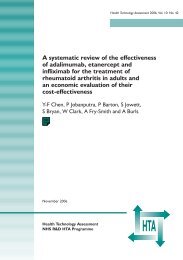Evaluation of liposomes coated with a pH responsive - University of ...
Evaluation of liposomes coated with a pH responsive - University of ...
Evaluation of liposomes coated with a pH responsive - University of ...
Create successful ePaper yourself
Turn your PDF publications into a flip-book with our unique Google optimized e-Paper software.
3.0 Results<br />
The results presented in this section are discussed in section 4.<br />
Table 1 shows the vesicle zeta potential as a function <strong>of</strong> polymer concentration, where the<br />
polymer concentration shown is that <strong>of</strong> original solution that was mixed <strong>with</strong> the <strong>liposomes</strong>.<br />
As no further decrease in zeta potential was seen by increasing the polymer concentration<br />
beyond 0.05 % this was assumed to be the concentration necessary to cover the surface <strong>of</strong> the<br />
<strong>liposomes</strong> and was that used in all further studies. Vesicle size (Table 1) was seen to increase<br />
<strong>with</strong> increasing polymer concentration until 0.05 % at which point there was a plateau similar<br />
to that seen for the zeta potential results.<br />
Evidence <strong>of</strong> an association between the polymer and <strong>liposomes</strong> was also seen using light<br />
microscopy. Figure 1A shows the un<strong>coated</strong> <strong>liposomes</strong> at <strong>pH</strong> 6.3. Typically for MLVs, the<br />
size <strong>of</strong> the vesicles was originally around 5 - 10 µm. On addition <strong>of</strong> polymer to a system at<br />
<strong>pH</strong> 7.8 no increase in size was observed (Figure 1B), consistent <strong>with</strong> the fact that the polymer<br />
was in solution at these conditions. At <strong>pH</strong> 6.3 the polymer was seen to precipitate around the<br />
vesicles forming larger agglomerates (Figure 1C). A control experiment (results not shown)<br />
in which <strong>liposomes</strong> were excluded showed that polymer ‘particles’ resulting from<br />
precipitation at <strong>pH</strong> 6.3 were considerably smaller (approximately 200 nm) than the <strong>liposomes</strong><br />
used in this study. In this way, the agglomerates seen in Figure 1C were assumed to be<br />
<strong>liposomes</strong> + polymer and not precipitated polymer alone.<br />
In Figure 2 typical images from cryo-EM are shown. In Figure 2A the lamellae and central<br />
aqueous core <strong>of</strong> <strong>liposomes</strong> are clearly visible. In the presence <strong>of</strong> polymer a crust was<br />
8
















